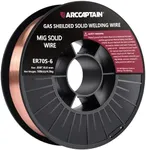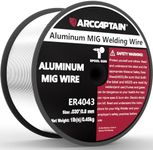We Use CookiesWe use cookies to enhance the security, performance,
functionality and for analytical and promotional activities. By continuing to browse this site you
are agreeing to our privacy policy
Best Welder Plasma Cutter Combo
From leading brands and best sellers available on the web.#2

YESWELDER
YESWELDER Plasma Cutter Welder Combo Gas MIG/Gasless MIG/Lift TIG/Stick/CUT 5 in 1 Welding Machine FIRSTESS MP200, Black
View Product
#3

Flameweld
Flameweld 3 In 1 Plasma Cutter Welder Machine - CTS520X Cut Tig Stick Dual Voltage 110/220V, 50Amps Plasma Cutter, 200Amps TIG Welder, 200Amps Stick Welder, 60% Duty Cycle 50/60Hz
View Product
Buying Guide for the Best Welder Plasma Cutter Combo
Choosing a welder-plasma cutter combo can be a smart move if you need both welding and cutting capabilities in one machine. These combos are versatile and save space, making them ideal for home workshops, small businesses, or anyone who wants to tackle a variety of metalworking tasks. To find the best fit, it's important to understand the main features and how they relate to your specific needs, such as the types of materials you'll work with, the thickness of metals, and how often you'll use the machine.Output Amperage RangeOutput amperage range tells you how much power the machine can deliver for both welding and plasma cutting. Higher amperage means you can work with thicker materials, while lower amperage is suitable for thinner metals and more precise work. If you mostly work on automotive panels or light fabrication, a lower range may be enough. For heavy-duty tasks or thicker steel, look for a machine with a higher maximum amperage.
Duty CycleDuty cycle refers to how long the machine can operate continuously before needing to cool down, usually expressed as a percentage of a 10-minute period. For example, a 60% duty cycle at a certain amperage means you can weld or cut for 6 minutes and then let the machine rest for 4 minutes. If you plan to use the machine for long stretches or in a professional setting, a higher duty cycle is important. For occasional or hobby use, a lower duty cycle may be sufficient.
Input VoltageInput voltage is the type of electrical power the machine requires, such as 120V or 240V. Machines that can run on both (dual voltage) are more flexible and can be used in more locations. If you only have standard household outlets, make sure the machine is compatible. For more demanding work, access to 240V power may be necessary.
Process Types SupportedWelder-plasma cutter combos can support different welding processes like MIG, TIG, and Stick, in addition to plasma cutting. The more processes supported, the more versatile the machine. If you only need basic welding and cutting, a simpler machine may suffice. If you want to tackle a wide range of projects, look for a combo that supports multiple welding types.
Material Thickness CapabilityThis spec tells you the maximum thickness of metal the machine can weld or cut in a single pass. It's important to match this to the materials you plan to work with most often. If you only work with sheet metal, a lower capability is fine. For structural steel or thicker materials, make sure the machine can handle the job.
Portability and SizePortability and size refer to how easy it is to move and store the machine. If you need to take your welder-plasma cutter combo to different job sites or have limited space, a compact and lightweight model is ideal. For stationary use in a workshop, size may be less of a concern.
Ease of Use and ControlsEase of use covers how simple the machine is to set up and operate, including the clarity of its controls and displays. Beginners will benefit from intuitive controls and clear instructions, while experienced users may appreciate more advanced settings. Consider your comfort level and how much time you want to spend learning the machine.







